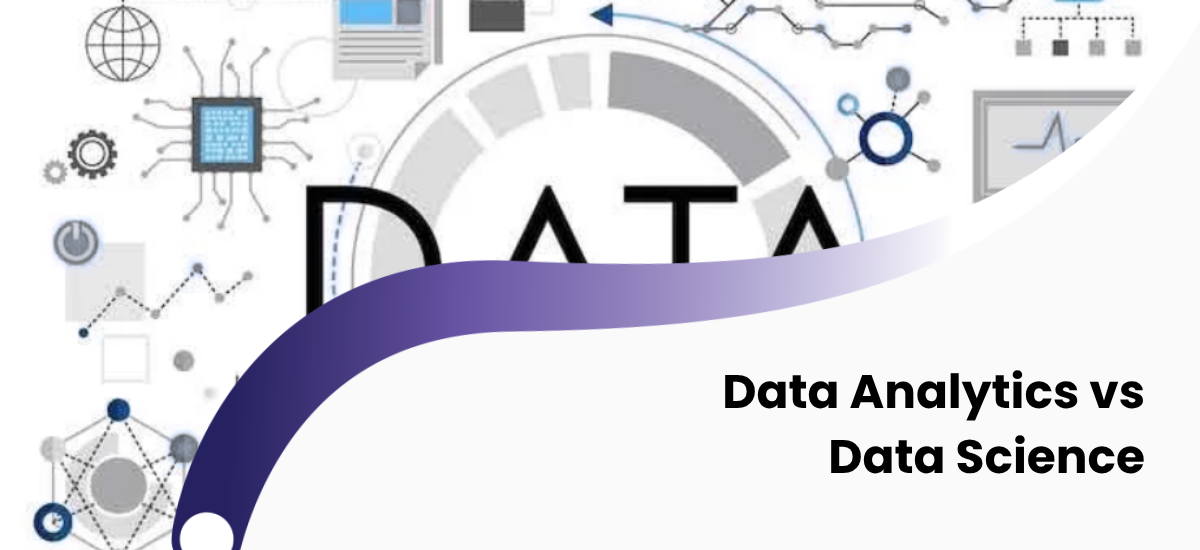Data has become the most valuable resource in recent years. Many companies talk about making data-driven decisions. However, in this world, two terms are frequently confused with each other: Data Analytics and Data Science.
Some think they are the same job or use one term in place of the other. But even though they may use similar tools, these are two separate fields that serve completely different purposes.
In short, Data Analytics tells you what happened, while Data Science tries to predict what will happen. This is the difference between describing past events and forecasting future ones.
Difference in Goals: Analysis of the Past vs. Prediction of the Future?
To understand the fundamental difference between these two fields, one must look at their primary objectives:
- A Data Analyst examines current and historical data, identifies problems, and reports on what happened. For example, they seek an answer to the question, why did sales decrease by 15% this month.
- A Data Scientist, however, uses this data to build models that forecast future trends. For example, they solve the question, how can we predict which customers will leave us next month.
Consider an online retail site. The Data Analyst prepares reports and dashboards analyzing which products sold the most last month and at what stage customers most frequently abandoned their carts. The Data Scientist, looking at this data, builds an algorithm that gives customers personal product recommendations or a Machine Learning model that predicts when a product will run out of stock.
The 3 Main Differences Between Data Analytics and Data Science
Although these two fields complement each other, they differ in three main ways:
1. Purpose and Focus (Report vs. Forecast)
The most fundamental difference is in the questions they answer.
- Data Analytics: The focal point is understanding what happened in the past. It seeks answers to the questions what happened and why it happened. The goal is to diagnose the current situation and prepare reports and visualizations for business decisions. This is more closely related to Business Intelligence.
- Data Science: The focal point is predicting the future. It seeks answers to the questions what will happen and what should we do. The goal is to find hidden patterns in the data and build predictive models. This is tightly linked with Machine Learning and Artificial Intelligence (AI).
2. Tools and Techniques Used
While both fields share some tools, such as Python and SQL, their methods of use differ.
- Data Analytics: Primarily uses tools to clean, analyze, and visualize data. The most popular tools are SQL for pulling data from databases, Excel for quick analysis, and platforms like Tableau or Power BI for interactive visualization.
- Data Science: Requires more complex tools. In addition to SQL, it uses languages like Python or R to build statistical models and machine learning algorithms. They require more coding and mathematical knowledge.
3. Type of Data (Structured vs. Unstructured)
This is a technical but important difference.
- Data Analytics: Typically works with orderly, table-based structured data. This data is found directly in databases, such as sales records or customer lists.
- Data Science: Often has to work with both structured and unstructured data. This includes texts (emails, social media comments), images, videos, and other mixed data types. Extracting meaning from this data requires more complex algorithms.
Conclusion: Do You Need an Analyst or a Data Scientist?
As you can see, Data Analytics and Data Science do not replace each other; on the contrary, they are complementary. A company needs both to understand its past performance (Analytics) and to predict its future steps (Data Science).
Without Data Analytics, Data Science would not know what problem to solve. And without Data Science, the findings of Analytics would simply remain in the past and not turn into an action plan for the future.
At Crocusoft, we know how vital data is for your business. The custom software, ERP, and CRM systems we create do not just collect your data; they store it in an organized and structured way. This creates a solid foundation for both powerful data analytics and the future application of data science models.
Frequently Asked Questions (FAQ) About the Data Field
1. What is Business Intelligence (BI)?
BI (Business Intelligence) is closer to Data Analytics. The main purpose of BI is to visualize data (like with Power BI or Tableau) and prepare dashboards for executives to make fast decisions. Data Analytics, however, investigates the underlying reasons for that data more deeply.
2. Is it mandatory to know Python to be a Data Analyst?
It is not mandatory, but it is a major advantage. Many Data Analysts can get their work done using SQL and Excel or Power BI. However, knowing Python allows for the analysis of larger and more complex datasets. To become a Data Scientist, knowing Python or R is almost compulsory.
3. Which field has a brighter future?
Both. Data Analytics is critical for the day-to-day operations of companies and will always be in demand. Data Science is the field that gives companies a competitive advantage (Artificial Intelligence, Forecasting) and is becoming increasingly valuable. The choice depends on your interest: solving existing problems (Analytics) or modeling the future (Data Science).
 +994512060920
+994512060920





